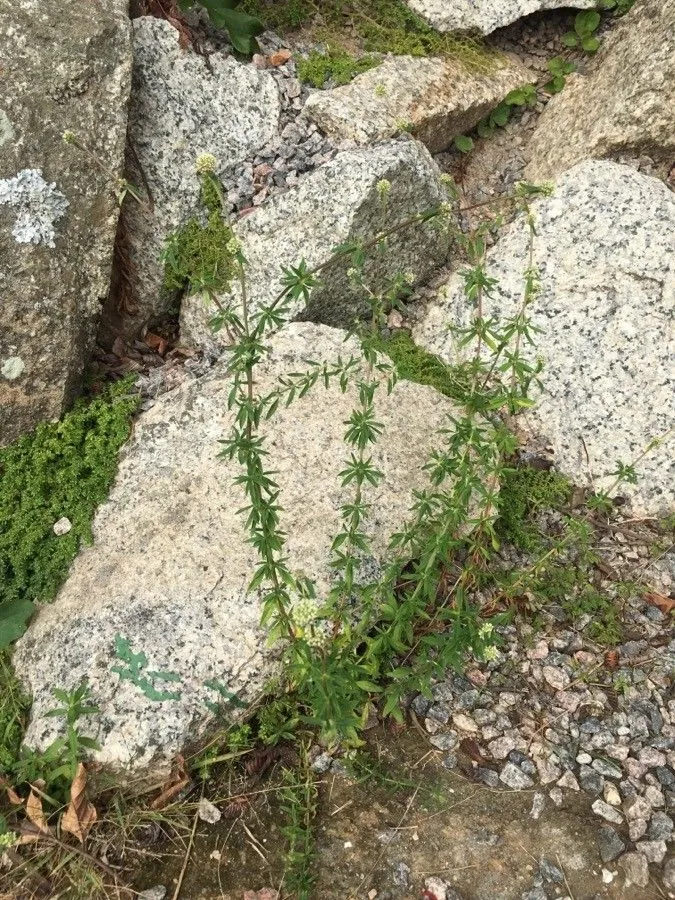
Author: L.
Bibliography: Sp. pl. 1:102. 1753
Year: 1753
Status: accepted
Rank: species
Genus: Spermacoce
Vegetable: False
Observations: Trop. & Subtrop. America
Shrubby false buttonweed, scientifically known as Spermacoce verticillata, is a notable member of the Rubiaceae family. First described in 1753 by Linnaeus in his seminal work “Species Plantarum” (Sp. pl. 1:102), this plant species is indigenous to tropical and subtropical regions of the Americas.
Characterized by its distinctive shrubby habit, Spermacoce verticillata thrives in a variety of environments across its native range. The plant prefers sunny locations and often inhabits grasslands, roadsides, and open forests where it can receive ample sunlight.
Morphologically, shrubby false buttonweed displays a semi-woody structure that can grow quite robust if conditions are favorable. The stems are typically covered in fine hairs, and the leaves are arranged oppositely along the stem, presenting a whorled appearance that is characteristic of the genus. The leaves are lanceolate and have a vibrant green coloration, contributing to the plant’s bushy and attractive growth habit.
The flowers of Spermacoce verticillata are small yet numerous, forming dense clusters at the axils of the leaves. Each blossom typically has a white to bluish hue, which serves to attract various pollinators, including bees and butterflies. These tiny flowers later develop into seed capsules, ensuring the propagation and survival of the species.
In terms of ecology, shrubby false buttonweed plays a role in stabilizing soil and preventing erosion, particularly in disturbed areas where it often establishes itself. Its adaptability makes it a resilient plant capable of enduring different environmental stresses.
Despite its usefulness in certain ecological niches, the plant can become invasive outside its native range. In such scenarios, it outcompetes local flora, leading to biodiversity loss. Therefore, careful management practices are essential to keep its proliferation in check in non-native regions.
Spermacoce verticillata serves not only as an interesting subject for botanical study but also highlights the complex dynamics of plant species in their ecosystems. Its broad distribution across tropical and subtropical America underscores its adaptability and ecological significance.
In summary, shrubby false buttonweed is a plant of considerable interest due to its distinctive morphology, ecological roles, and adaptability. With careful study and management, its benefits can be harnessed while mitigating any adverse impacts on non-native ecosystems.
Eng: shrubby false buttonweed
En: Shrubby false buttonweed, Shrubby false buttonwood
Taken Aug 11, 2010 by Tela Botanica − Sylvain PIRY (cc-by-sa)
Taken Dec 28, 2021 by Trap Hers (cc-by-sa)
Taken Feb 17, 2015 by Nelson Zamora Villalobos (cc-by-nc)
Taken Jun 1, 2021 by Fernando da Luz Schmidt (cc-by-sa)
Taken Jul 20, 2021 by Trap Hers (cc-by-sa)
© copyright of the Board of Trustees of the Royal Botanic Gardens, Kew.
© copyright of the Board of Trustees of the Royal Botanic Gardens, Kew.
© copyright of the Board of Trustees of the Royal Botanic Gardens, Kew.
Taken Nov 27, 2021 by Fraga Rafael (cc-by-sa)
Taken Jun 1, 2021 by Fernando da Luz Schmidt (cc-by-sa)
Taken Jun 24, 2019 by Denis Bastianelli (cc-by-sa)
Taken Jul 20, 2021 by Trap Hers (cc-by-sa)
Taken Feb 11, 2022 by Azevedo Liliane (cc-by-sa)
Taken Feb 11, 2022 by Oliveira Vander (cc-by-sa)
Taken Jan 16, 2022 by Maarten Vanhove (cc-by-sa)
Taken Aug 22, 2022 by Thompson George (cc-by-sa)
Taken Jan 25, 2022 by Ana Maria Moreira da Silva (cc-by-sa)
Taken Jun 1, 2021 by Fernando da Luz Schmidt (cc-by-sa)
Taken May 27, 2021 by Maarten Vanhove (cc-by-sa)
Taken Mar 6, 2015 by Tela Botanica − Sylvain PIRY (cc-by-sa)
Taken Apr 17, 2021 by Ofe Ilu Odde (cc-by-sa)
Taken Dec 4, 2019 by Tela Botanica − Sylvain Piry (cc-by-sa)
Growth habit: Subshrub
Family: Myrtaceae Author: (F.Muell.) K.D.Hill & L.A.S.Johnson Bibliography: Telopea 6: 402 (1995) Year: 1995 Status:…
Family: Rubiaceae Author: Pierre ex A.Froehner Bibliography: Notizbl. Bot. Gart. Berlin-Dahlem 1: 237 (1897) Year:…
Family: Sapindaceae Author: Koidz. Bibliography: J. Coll. Sci. Imp. Univ. Tokyo 32(1): 38 (1911) Year:…
Family: Asteraceae Author: A.Gray Bibliography: Pacif. Railr. Rep.: 107 (1857) Year: 1857 Status: accepted Rank:…
Family: Fabaceae Author: Medik. Bibliography: Vorles. Churpfälz. Phys.-Ökon. Ges. 2: 398 (1787) Year: 1787 Status:…
Family: Aspleniaceae Author: (Cav.) Alston Bibliography: Bull. Misc. Inform. Kew 1932: 309 (1932) Year: 1932…